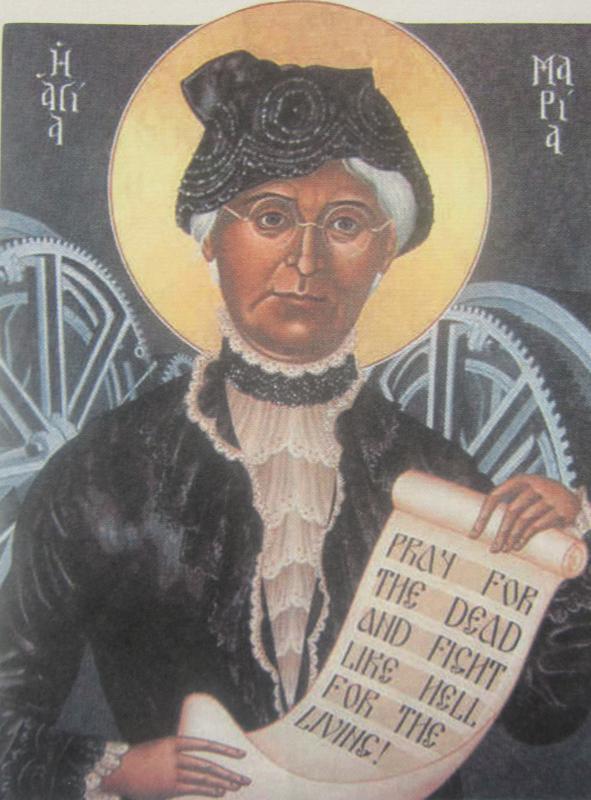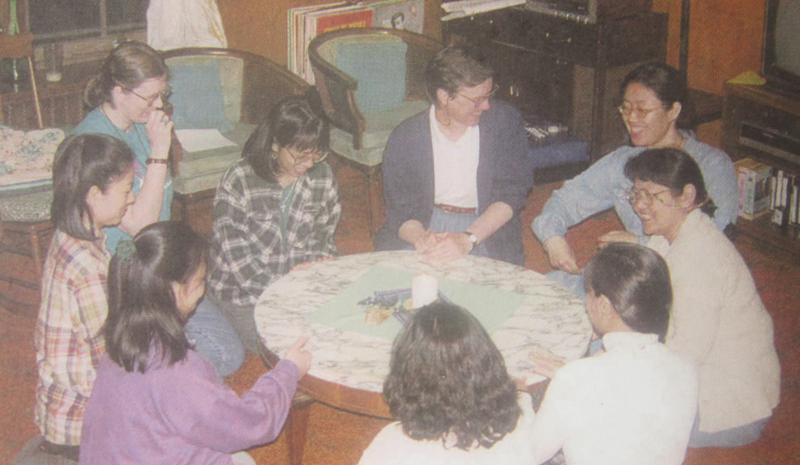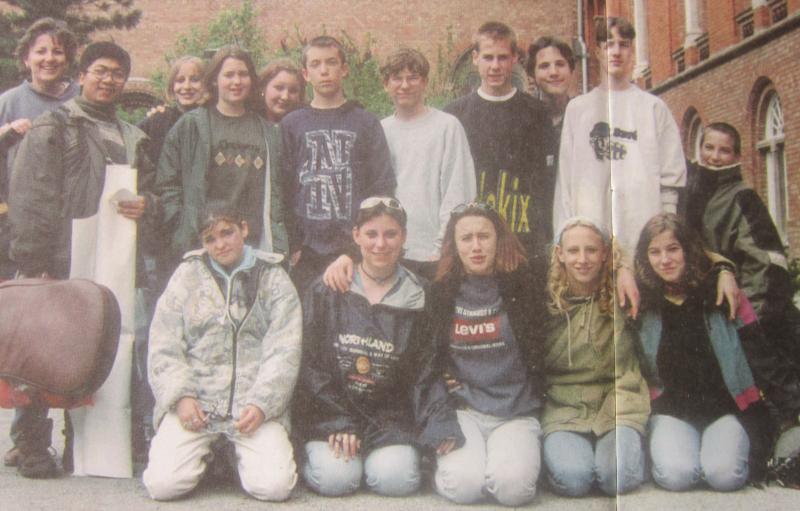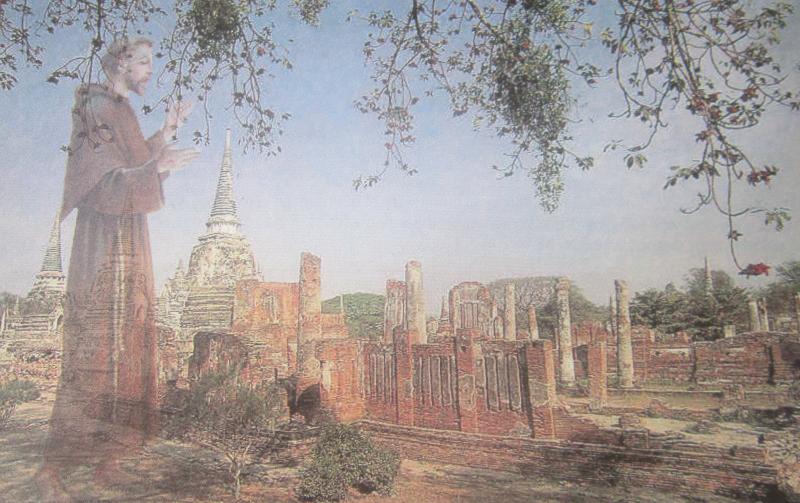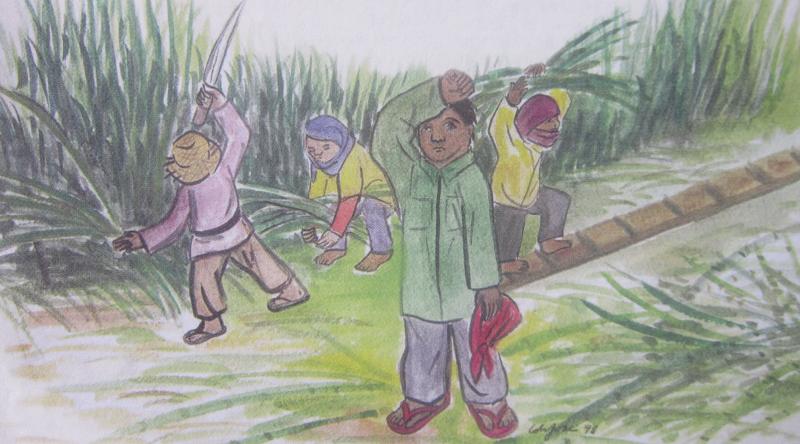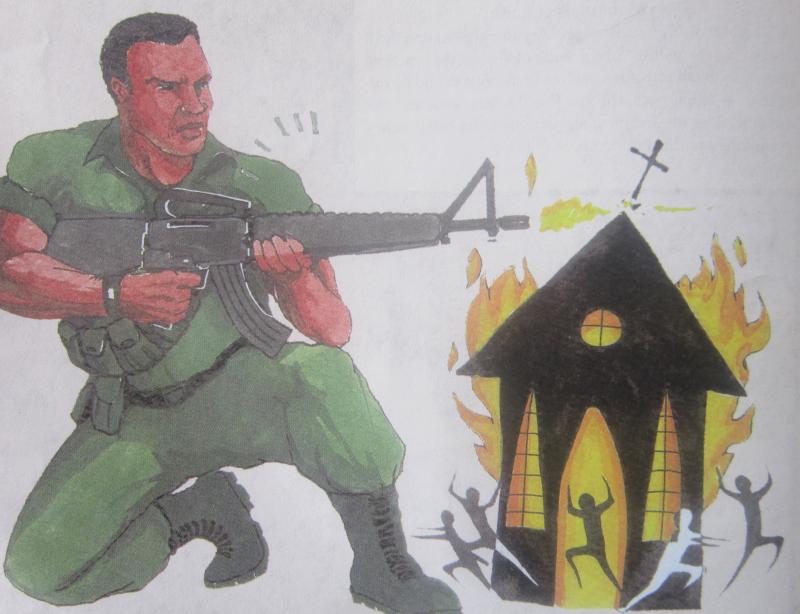November-December 1999
A Letter From Ivory Coast
Hello Fr. Des,
 My Missionary Vocation started in 1967 when I arrived in the former Upper Volta, now called Borkina Fasso, where I stayed, where I stayed for 15 years. Then I went to Niger, near the Sahara desert, and stayed for 2 years. Then I arrived in the Ivory Coast, where I have stayed for 8 years-27 years in all!
My Missionary Vocation started in 1967 when I arrived in the former Upper Volta, now called Borkina Fasso, where I stayed, where I stayed for 15 years. Then I went to Niger, near the Sahara desert, and stayed for 2 years. Then I arrived in the Ivory Coast, where I have stayed for 8 years-27 years in all!
As you know, Ivory Coast is a French speaking country in West Africa. We are running a secondary school with 450 girl students. I teach English as a second language. We have no problem regarding discipline and work because their future lies in the success of their studies. The majority of our students are animists. The rest are Muslims and Christians.
Last Eater Sunday, we had baptism for adults including marriages, confirmation and First Holy Communion. The couples received all these sacraments at the same time. The Mass lasted for four hours in the midst of African songs and drums.
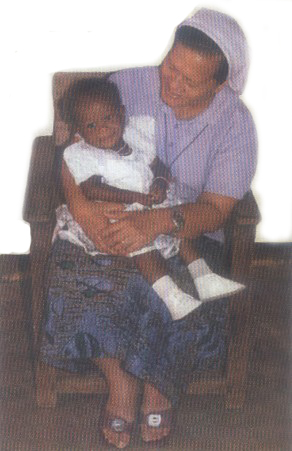 As to the government, we have the democratic system. The present president is the second since the independence from France in 1961. Economically, the country is rich in coffee, coconuts and rubber plantations. Fishing is well developed. However the ‘Big Powers’, especially Japan and China, are sucking out the country’s wealth as in the case of the other Third World countries – the rich getting richer and the poor getting poorer. There are few foreign missionaries here since native women congregations exist and we now have a lot of local diocesan priests. In 1995, we celebrated one hundred years of Christianization by the First French priest missionaries.
As to the government, we have the democratic system. The present president is the second since the independence from France in 1961. Economically, the country is rich in coffee, coconuts and rubber plantations. Fishing is well developed. However the ‘Big Powers’, especially Japan and China, are sucking out the country’s wealth as in the case of the other Third World countries – the rich getting richer and the poor getting poorer. There are few foreign missionaries here since native women congregations exist and we now have a lot of local diocesan priests. In 1995, we celebrated one hundred years of Christianization by the First French priest missionaries.
How did the missions change me? I have learned to live with black and white people and I am able to survive with the basic necessities in life, in the absence of comfort. I have learned to adjust to a simple lifestyle and a different mentality.
Love for the African people and being loved by them has changed my way of living and loving.
In Christ,
Sr. Maria Isabel
BP 156, Dalao, Cote d Ivoire
West Africa
A Most Dangerous Woman
By Sr. Joan Chittister
Mary Jones was born in Cork, Ireland in 1830. She worked as a seamstress and schoolteacher, bore four children, emigrated to the United States when Victorianism was in its heyday and, at an early age, lost her husband and all her children to smallpox. She was one of thousands of strong and long suffering women who lived in poverty and survived it. In her long, black dress and broad-brimmed hat, she was the prototype of every turn-of-the-century grandmother in the United States. Except that she wasn’t. Underneath the patina of propriety and modest seemliness beat the heart of the lion of Judah who knew injustice and decried it, who knew the story of Exodus and believed it.
The Glided Age
She was a struggling contemporary of Andrew Carnegie and John D. Rockfeller. She lived during the period of the rise of the railroads, the invention of the telegraph, the production of the automatic revolvers, the passage of the US Gag Law. The Law was aimed at suppressing the growing debate on slavery and the specter of day labor – the practice of hiring people by the day or sometimes only by the hour work a week, the exploitation of child labor, the sweatshops, the slum housing projects, the lockout of laborers who protested the inhuman working conditions, the blacklisting or universal rejection of laborers who dared to complain, a court systems for industry rather than the work force that produced the products – all these gave painful birth to the US labor movement. The “Glided Age” they called it, the age in which things looked beautiful on the surface. And Mary Harris Jones was in the midst of it all.
Holy Gadfly
The day-laborer Mary Jones became a founding member of the Knights of Labor, a utopian organization that welcomed blacks, immigrants and women into its ranks but that, having turned violent in the Haymarket Square Incident, lost public credibility and effectiveness. But Mary Jones was not discouraged. Committed to the God-given quality of the task, she waded into mining towns to establish the United Mine Workers. She organized ‘mop and broom brigades’ of the miners’ wives. They beat up pans to scare coal-hauling mules away in order to disrupt production at the mines. She organized a ‘children strike’ around the motto: We want time to play. She became an all-around holy gadfly. The miners called the staunch old lady Mother Jones, a title she valued far more than Madam.
Unlikely Moses
With a kind of prophetic passion, she spent sixty years of her life organizing for the labor union movement and compared it to the flight of Jews from Egypt. What Moses did, she figured, was simply to organize the Jews to confront their Egyptian slave masters. And she one industrial site after another by refusing to quit. “Fight like hell till you get to heaven,” she counseled people, and she gave them a fair idea of how it was be done as well. Mother Jones was seventy-two years old when a federal representative called her ‘the most dangerous woman in America.” She burned all her life with the fire of justice and signed everyone she touched with it.
Rising Against Oppression
She was an unlikely Moses in an unlikely desert, and today we have need of the likes of Mother Jones again. We need ordinary people like her uncommonly common folk teachers, government employers, wives and mother s, construction workers. Citizen who refuse to accept the fact that the government has money to burn on faulty roads, brand new cars for government officials and armaments but has not a penny to spend on squatters areas, street children, higher education for the poor. “Government interference” they call it when it is designed to provide programs for average people. “Investment incentives” they call it when it is designed to provide unconscionable profits” they call it when it is designed to exploit the cheap labor of Third World countries like the Philippines with never cent of taxes paid to the people for development of their own country in return. Indeed, Mother Jones needs to rise again in all of us.
Ugly System Changed
The problem is, of course, that we so easily abstract ourselves from the ranks of the heroic and the brave. They constitute, we assume, a specie beyond dailiness, beyond the neighborhood, beyond the realms of the normal. We admire them, but we seldom see them in the mirror of our lives. And that’s where Mother Jones comes in: old, female, grandmotherly widowed, childless, and financially destitute; she is the phantom and symbol of all our powerless lives. The difference between Mother Jones and most of the rest of humankind is that Mother Jones looked at the world through the eyes of God and announced what she saw: exploitation, corruption and injustice. Then, piece by little piece, she did something to change it: a mining town here, a meeting there. What was was not good enough for her. And thanks to her, a rich and massive system was forced to change.
Mother Jones is model of perseverance. By the time she died at the age of one hundred she had spent the greater part of her life speaking out for the needs of others.
A New Road To Holiness
By Amy Rebecca Radil
The women padding into the living room in sweaters and leggings were nuns in training. Sitting on sofas and cushions with caftans tucked around them, they held paperback Bibles and began the day with music and prayer. Sr. Rita Burdz, one of the group’s leaders, lit a candle on the center table. An ethereal chorale played on the stereo. The orientation home of the Maryknoll Sister, and order of the Catholic Missionaries, resembled nothing so much as a well-kept sorority house. Its spacious, sunny rooms were filled with plants, books and worn but comfortable furniture, along with objects sent as gift from Sisters abroad.
Hard-nosed Activities?
At the conclusion of prayers during their opening meeting, the women took on the air of hard-nosed activists. Giang Nguyen and Cathy Encarnacion reported on a recent trip to Mount Vernon’s City Hall; they pulled out a sheaf of documents on the town’s homeless population. They divided them up for reading and discussion. The bureaucratic reports left them skeptical. Lee, a petite woman in red sweaters and a ponytail, got impatient as she read aloud the town’s explanation as to why it has no comprehensive program to treat the homelessness. “This sound like excuses,” she said. “I don’t see any specific ideas.” “Id like to know own much goes directly to the homeless,” said Marvie Misolas, a second year candidate, reviewing a sheet of financial information; they talked about numbers of homeless in town and facilities to threat them, then the conversation gradually turned to larger issues of poverty and socials ills.
Satisfying Conversation
Breaking for lunch, everyone gathered in the large dining room for a home-made meal. The tone was frank, funny and some would say feminist as they discussed marriage practices around the world and they ways women get trapped in bad ones. Cathy recounted the ludicrous plot of a Filipino movie in which woman sacrifices everything for her husband and children, even agreeing to let his mistress move into their home. Everyone at the table cracked up at the movie’s attempt to portray “proper” women.
But what was notable, and different from other all-female conversations, was the way they interwove the usual anecdotes with larger ideas of social justice and faith. The women spoke easily and sincerely about scriptures as well as local and global concerns. Houghton, a first year-candidate, said she made the decision to take vows when a friend invited her to a gathering of Maryknoll Sisters, “and I realized that my values matched theirs."
Fighting A Vocation
Houghnon and the other candidates at the orientation said it’s not uncommon for women to fight their own sense of vocation, even when they feel it from childhood. Mai Nguyen, a tiny woman with dark hair, doesn’t at all look her 37 years. “We’re all women who have experience in life,” she said. Nguyen got her bachelor’s degree in management at the University of Texas and traveled for her work, setting up business, before coming to the sisterhood. “I never expected it,” she said. “My image of a nun is so holy and religious. I’m not,” she stressed. “I fought back.” But religion won. “I was searching for something deeper.” Nguyen admitted.
Discouraging Rush Choices
During the admissions process, the Sisters question candidates closely to make sure they understand the sacrifices involved, especially foregoing marriage and having children. They discourage women from making rush choices. Houghnon says she chose Maryknoll in part because they were the only ones who didn’t push.” Cathy Encarnacion, who grew up in the Philippines, said that from age 10 through college she was focused on joining sisterhood. “In my third year of college they said, ‘Go experience life. have a boyfriend.’ I finished college and forgot about religious life.” But seven years and two boyfriends later, she returned.
Radical Choice
When asked whether she and the other women ever had doubts about their decision to join the Sisterhood, Encarnacion replied, “Yes of course, all the time,” But since the orientation began, no one has voiced regret or said they made the wrong choice. Families often greet their decision to join with disapproval or regret. They find it hard to conceive of such a radical choice, and they want their daughters to have families of their own.
Giving up her existing family, let alone a future one, was no small matter for Cathy. For her, cultural considerations figured hugely in her reluctance to join Maryknoll. Becoming a missionary meant leaving behind her close-knit family of nine siblings. “I was still living at home with my family at 28,” she said. Becoming a sister also meant joining a group linked to the former colonizers of her country. “One of the biggest tensions was the American heritage of Maryknoll,” she said. “But when I studied it more, I admire the cross-cultural aspects, going beyond boundaries. There’s not just one oppressive culture, there’s good and evil everywhere.”
But even an organization like Maryknoll that prides itself on its intercultural awareness has gone through a growth process toward greater sensitivity as more women from outside the United States have joined and attained senior leadership positions. But some aspects of their work is unchanging, including the Sister’s guest for social justice and ultimately for holiness.
Angola Diary
By Fr. Efren De Guzman svd
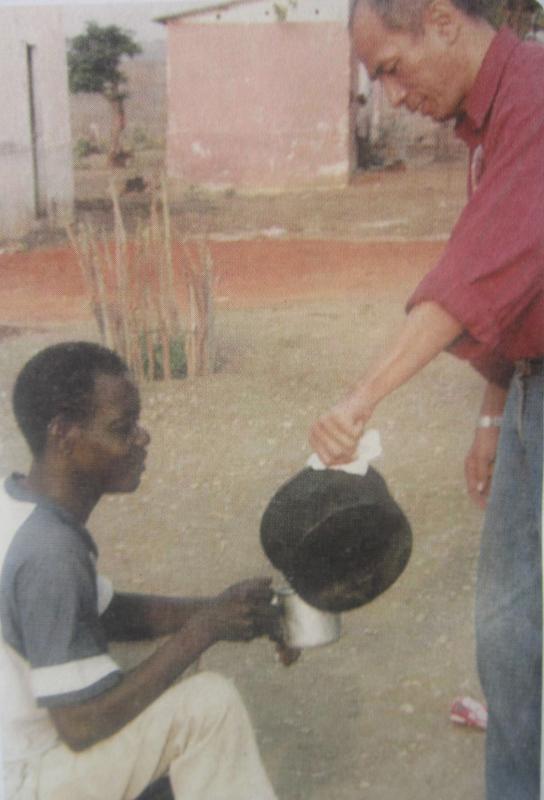 Dear Misyon Friends,
Dear Misyon Friends,
In the many uncertainties we are experiencing here in Angola or whenever I’m down, I praise and thank God that we have special friends like you, friends with compassionate hearts who wish to pray and support our work for the poorest of the poor.
I don’t know when God will take my life through sickness assault, landmine explosion or accident. So let me tell you, as I try to express this brotherly feeling within the limitations of a letter, how close you are to my heart.
December 1. Some of our friends in Cazega were hesitant to report to the authorities that almost every night in their area, some armed people were entering houses, robbing and raping women. One of the victims was woman who just given birth, later she died of infection. The people were so furious that when they caught the perpetrator, who was a military deserter and a drug addict, they tortured him and burned him alive.
December 24. We made a lot of preparation for Christmas:1. The distribution of food for lepers, handicapped, abandoned old people and orphans.
2. The rehearsal of our drams on the birth of Jesus.
3. Planning and implementing of 1998 reports especially those for the internal refugees whose project proposal need to be presented on the second week of January.
December 29. Another ambush by deserters in Ukua. Some people were wounded others were killed.
December 30. The Government repeated the ultimatum date (Jan. 22) for the UNITA rebels to hive up the rest of their hidden arms. All their offices and assets outside Angola have been closed. Some UN observers commented that the UN Council should also punish the Angolan Government for buying more new arms instead of investing the money for education and livelihood programs and helping demobilized soldiers.
January 1. During our Bible sharing a mentally sick woman, named Mesma, began ringing the Church bell yet again. The people tried to stop her, but to no avail. She would just run away, then later on come back to ring the church bell again. One of our elders name Indo, commented, perhaps, Mesma is a reminder to us of the many mentally sick people roaming around but nobody cares for them. We have centers for the amputees, for the lepers, for the orphans but not a home for the mentally sick.
Love,
Fr Efren De Guzman, SVD
Funda Leper Colony, CP 1326
Luanda, ANGOLA
Bokis Kontrak
The Ark of the Covenant
By Sr. Mary Gabrielle osc
Guinea highlanders have been following a modern day Ark of the Covenant. It all begun when the people in the Diocese of Wabag wanted to commemorate the first coming of the SVD missionaries 50 years ago. The idea of carrying a Bible from parish to parish following the path of the early missionaries came up. The Bible was to travel in style – in a specially decorated wooden and glass box, modeled after the Ark of the Covenant, or as they termed it “Bokis Kontrak”. This was to symbolize the presence of God’s Word in their midst. For four months, they carried the ark around the parishes of the diocese. It was never left alone night or day, rain or shine.
Special Retreats
Each parish went through months of preparation for receiving the “Bokis Kontrak”. Retreat teams were trained in each parish and they went around leading week-long retreats. It was a time of renewal and many people who had been on the fringes of the Church came back to be full members. Some groups and tribes that had been fighting had to make peace so that the “Bokis Kontrak” could come to their community. On the last day of the celebration for the high Mass, parishioners from each parish in the whole Diocese gathered in the mission station where we are residing and the crowd was almost 15, 000 people.
2-hour Mass
For special Mass celebrations, the Bible is being carried by a man with “bilas” (traditional costume) with two candle bearers and with women, also in their bilas, singing and dancing from the front door of the church going to the altar. They do a lot of dancing and singing in the Mass, during offertory and consecration. Sometimes a drama about the readings of the Gospel performed. The people are fond of singing charismatic songs, even toddlers could sing with hands clapping lively. That is why their Mass lasts for two hours or more. Men, women, and children come for Mass with roasted camote (kaw-kaw) in their bilum so that after Mass they could have their meal anywhere as they walk for one to two hours in going back to their homes.
The Bilum
Engan women are experts in making traditional bilum – a knitted string bag done with a one-hook needle. The bilum symbolizes family’s riches because they carry their babies in them to keep warm and protect them from anything that is harmful. Men, women, and children bring their own bilum wherever they go. They carry it on their heads. It is also a sign of friendship, of intimate relationship, even of love. It is a very personal gift of a man marrying a woman. When somebody gives a bilum to a missionary, this means that you are very welcome and loved by the people.
Mountains of Faith
Papua New Guineans, especially the highlanders, still seem to be living only “one decade old” after the creation. There’s so much effort needed for their growth and development – a long way to go. But the missionaries, like Moses leading the Israelites, are with them on this journey – a journey to the mountains of faith.
When I was a little girl I used to sit alone with nature around me or stay in the nearly chapel just sitting there in silence, listening to the growing sounds of the day. This was perhaps one of the happiest memories of my childhood and now I realize why I was doing this even at an early age. God was preparing me to a contemplative way of live, resting in His divine embrace in peace and joy and living in His Love... through prayer.
Christmas Came Early
Extracts from an article by Ceres Doyo
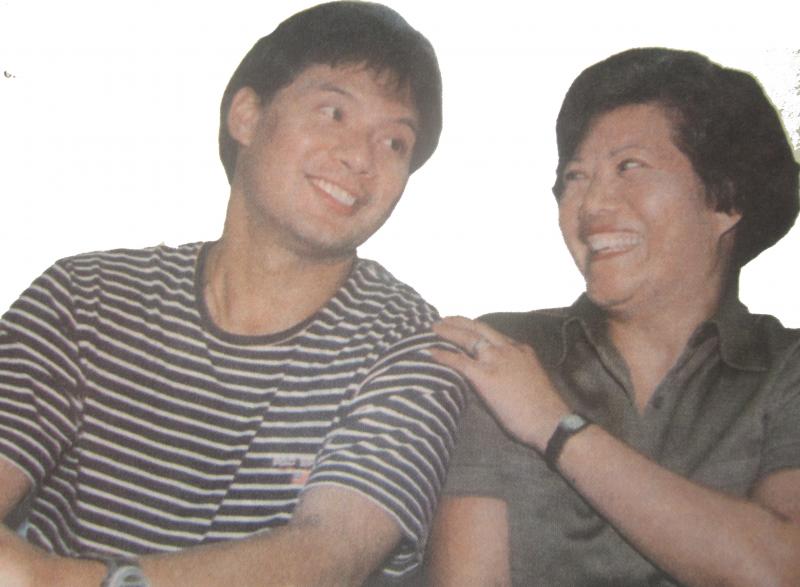 1970, Negros Occidental. Elenita Flores was 19, a senior at the West Negros College in BacolodCity. Nita was not typical teenager who sang about the Age of Aquarius and wore beads and platform shoes. Her concerns were different – teaching catechism, completing her education, living up to the expectations of her big family in the town of Kabankalan.
1970, Negros Occidental. Elenita Flores was 19, a senior at the West Negros College in BacolodCity. Nita was not typical teenager who sang about the Age of Aquarius and wore beads and platform shoes. Her concerns were different – teaching catechism, completing her education, living up to the expectations of her big family in the town of Kabankalan.
Nita’s home province was in the throes of social upheaval. The few rich were very rich and the poor, to which Nita’s family belonged, were getting poorer. Nita’s family was struggling but was not the poorest of the poor.
Nita was in her last years in college, majoring in Education, when she felt her life reaching a dead end. She was listless and raging inside. She had just broken off with her boyfriend. Back home in Kabankalan, things were not easy, Nita felt alone with no one to turn to.
Then a man came along, much older and had a family. “I didn’t even know what his full name was,” Nita recalls today, unable to hide her loathing. She does not want to dwell on the details of their relationship, if one could call it a relationship, at all. They were not even friends. But they were seeing each other. One thing led to another. Nita was a reserved rural lass but here she was sleeping with a man she hardly knew. It all seemed so strange. One day, she felt different. “I did not have a test but I knew I was pregnant,” Nita says. By then the man, whose name she now cannot utter, was out of her life. Did she love him? “No,” she answers without hesitation. He did not love her either. But they – no, she – was going to have a baby.
Graduation
It was March 1971 and she was graduating from college. Nita was present at her graduation rites, but her mind was somewhere else. She was three months pregnant. What was she going to do next? Where could she run for help? What would happen to the baby inside her?
The last thing Nita wanted was her parents or anyone else finding out what had happened. She was the eight of nine children. She was never a devil-may-care kind of girl, she was an obedient daughter. How had she come to do this? Did she think of ending the pregnancy? “No, never,” Nita answers boldly. “I had made one mistakes, why make two mistakes?” Did she want the man to know she was having a child? “No.”
Enter Jalandoni
Nita’s first refuge was the Church. She walked into one in Bacolod City to look for a priest, and so Fr. Louie Jalandoni, then Social Acton director of the Bacolod Diocese. Although his job drew him to burning issues in this province that uneasily sat on restless social volcano, Fr. Louie always found the time to listen to personal problems. Nita had heard of this priest who had come from wealthy family and was working among the very poor, opening their eyes to their oppression.
Options
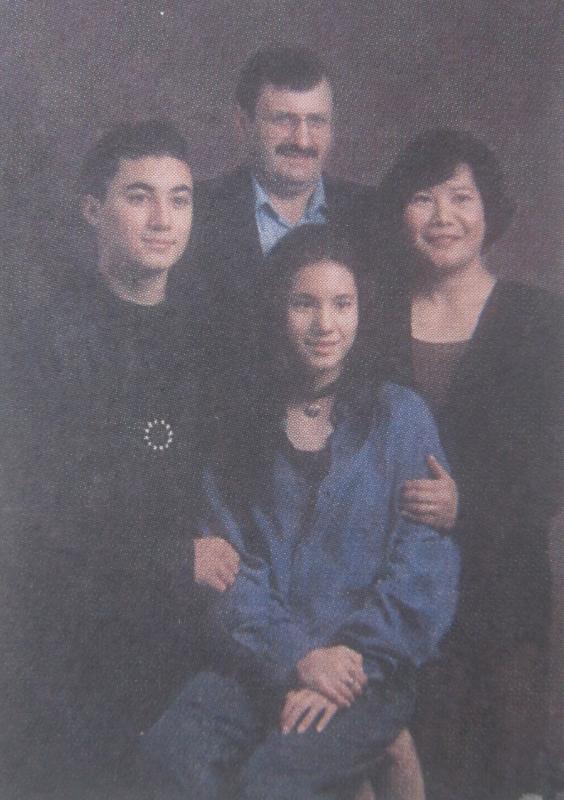 Fr. Louie discussed Nita’s option with her. In no time, Nita was leaving for Manila. Nobody at home knew about Nita’s condition. She left Negros, saying she was going to undergo further religious instruction or explore job possibilities in Manila with the help of some church people. Fr. Louie paid for Nita’s ticket.
Fr. Louie discussed Nita’s option with her. In no time, Nita was leaving for Manila. Nobody at home knew about Nita’s condition. She left Negros, saying she was going to undergo further religious instruction or explore job possibilities in Manila with the help of some church people. Fr. Louie paid for Nita’s ticket.
Sr. Fely Villaruel of the Cenacle Sisters took care of Nita for a while. When she was in her fifth month of pregnancy, Nita went to the Heart of Mary Villa (HMV) in Malabon. Run by the Good Shepherd Sisters, the shelter is a refuge for unmarried pregnant girls and women who have nowhere to go and who need to get away while they weigh their alternatives. The sisters also take care of babies awaiting adoption.
Nita still remembers Sr. Concepta Bellosillo, the sister-in-charge at that time, as well as Sr. Pilar Versoza, a young nurse newly arrived from US novitiate and was assigned to the nursery. (Sr. Pilar now heads Pro-Life Philippines.)
A Baby Named Noel
On Sept. 30, 1971, Nita gave birth to a baby boy. “I heard Christmas songs as early as September,” Nita remembers, “that’s why I named him Noel.” She nursed her baby for almost a month and gave him the best she could offer. She knew she could not be the best mother to him at that time of her life. After several weeks, Nita handed Noel over to the nuns for adoption.
“When I first laid my eyes on my baby, I became even more determined to give him up,” Nita says “I didn’t want him to eat sand.”
End of the World
“Night and day I cried,” she recalls. “When I gave him away it was like the end of the world. A part of my life was gone.” That longing for him she cried with her everyday of her life, even long after she had married a man she loved and bore children by him. Nita never regretted her decision. She knew Noel was in good hands. She did not think they would ever meet again. But she always wondered where he was, how he was.
Nita went home to Negros shortly after she gave birth. Nobody knew that she had given birth to a child. She worked in a pawnshop for awhile. In 1974, Nita left for Canada.
Michael Angelo
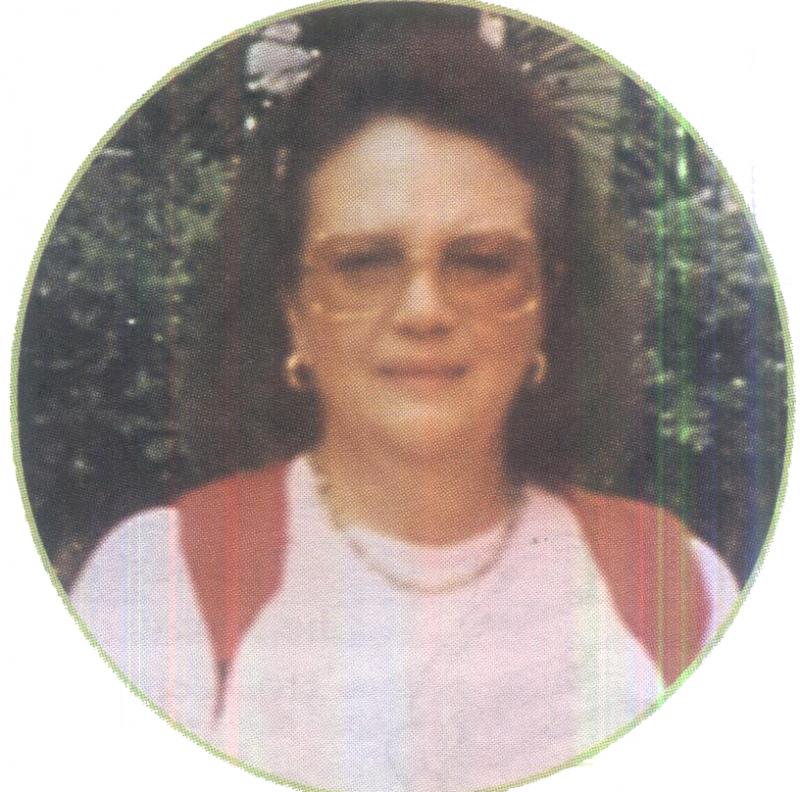 Federico Vigano, an Italian-Filipino, and his wife Beatriz Andregg, a Swiss citizen who grew up in the Philippines, were a childless couple who wanted to have a child to call their own. He was into cars, her family was into real estate. Both belonged to upper-class Caucasian community that had grown roots in the Philippines and established business here.
Federico Vigano, an Italian-Filipino, and his wife Beatriz Andregg, a Swiss citizen who grew up in the Philippines, were a childless couple who wanted to have a child to call their own. He was into cars, her family was into real estate. Both belonged to upper-class Caucasian community that had grown roots in the Philippines and established business here.
When they first saw the four month-old Noel at the Heart of Mary Villa, the baby reached out to them. Noel chose them. They named him Michael Angelo.
Happy Kid
“I always knew I was adopted,” Michael says causally. He does not remember when or how he knew but being adopted did not seem like a big deal to him then. Certainly he looked different from his fair-haired cousins and their friends – but he was one of them. He was doted on by his grandparents and aunts and uncles. “I was a happy kid. I had everything. I was close to my mom but I was surrounded by yayas,” Michael laughs.
Michael spent his early childhood in Manila and also in Davao, where his grandparents’ business thrived at that time. When Michael was 3 years old, his parents separated and he was left in his mother’s care. His father went back to Manila. Michael studied at the Ateneo de Davao and at the Colegio de San Agustin in Makati.
In 1981, when Michael was 10 years old, his mother Beatriz decided to go back to Switzerland and raise her son there. Then sometime in 1992, she was diagnosed as suffering from Lou Gehrig’s disease, which causes progressive deterioration of the nerves. Beatriz came back to the Philippines to spend her last days here.
She stayed at Rosario Apartments which her family owned in Malate. There the Columban Fathers of Malate Church visited her often to give her Holy Communion. Beatriz died on July 16, 1997. She lay in the state at the Malate Church were Fr. Michael Martin is parish priest today.
Paths that Cross
Strangely enough, Michael’s two mothers – Beatriz and Nita – could have easily crossed paths. And Michael could have been a mere arm’s length away from Canada. Just like Beatriz’s family, Nita’s family was also close to these Irishmen who served in Kabankalan, her hometown.
Michael’s Search
When Michael’s mother died in 1997 he became even more decided to look for his birth mother. It was Michael’s godmother (his mother’s aunt whom we shall call “Tita Ritz”) who had been keeping Michaels birth adoption papers all those years.
“I went to see Tita Ritz and she showed everything to me,” Michael recounts. She was there when Michael was first placed in his parents arms. Looking for his birth mom was like a suntok sa buwan. Would she want to see him? Where is she? Michael decided to call Heart of Mary Villa. Sr. Mila Santos answered the phone. When Michael told her about his search for his for his birth mother, Sr. Mila said: “I will write to your mom.” Michael had made the first step. “I was very excited,” he says.
The Letter
Then one day, now happily married in Canada also to a Swiss man, Nita received an extraordinary letter more than a month after it had been sent:
Dear Nita,
Peace! I am Sr. Mary Milagros Santos, the new superior of Heart of Mary Villa. Why I am writing you? Last September 8, 1998, I got a call from Michael Angelo (Noel). He is 27 years old already and inquiring about you. I told him I’ll write you and ask your permission if you want to get in touch with him. I got your address from the letter you sent in 1981 to Sr. Concepta, sharing with her how you are inquiring about Noel. I don’t know if Sister responded to it for after that there were no communications between you and the Sisters. I hope you will receive this letter and can write me back and advise me what to do.
Noel is Michael Angelo, still single at 27. His adoptive mother died last year and the adoptive father is sickly. He has a stable job. At this point of his life, he wishes to complete a missing piece in his heart even though he was loved very much by his adoptive parents. Getting in touch with you will help place this missing peace. He told me he is very grateful to you for giving him life and for your decision. There are no regrets.
I shared with him some description of you without revealing your name since I can do that only if you give me the permission to do so. Please write at once as his birthday is coming. God bless you and regards to Bob, Anthony and Cindy.
Love, Sr. Mila
Nita received the letter at 4 pm of November 1998. She was talking to Michael at 6 pm of that same day. But that is getting ahead of the story. It was Cindy, Nita’s 18-year-old daughter, who first opened the letter. Nita says she allows Cindy to open her letters for her. It was probably not mere coincidence that Cindy read the letter first, for in some indirect way, Michael, the half-brother she had to meet, had saved her life.
Catharsis
Four years earlier in 1994, Cindy, then 14, went through a crisis and almost ended her life. Nita got to her soon enough to shake her back to her senses. It was during the explosion of emotion that Nita tearfully blurted out: “I don’t want to lose another kid!” Cindy was stunned. She could not believe what she heard, “I don’t know why I said that,” Nita wonders now. It was probably a moment of catharsis for her and for Cindy as well. The raging storm inside the two of them had forced its way out.
Nita found herself telling the story of Michael. That turned things around for Cindy. Her brother Anthony learned about it as well. Nita’s husband Bob had known about it much, earlier. He understood and loved Nita just the same.
Time Stood Still
At 4 pm of Nov. 2, Nita had her mind on bowling. She was going out that night. Nita was working with her husband Bob at their office when Cindy called. She informed her mother that there was something important she should know. Cindy picked up her mother from work and they went home together.
At home, Cindy gave her mom the letter from Sr. Mila. “We read the letters together and we were both in tears,” Nita relates. Nita gave herself one hour to calm down. One hour later Nita made a call to the Philippines to speak with Sr. Mila. Nita could not describe her feelings. During their conversation Nita gave Sr. Mila “blanket authority to release all information to Michael.”
Sr. Mila called Michael immediately. “I got a call from your mom,” the excited nun announced. “She wants you to call her collect,” Right away Michael called Canada from his office. His friend left him alone in a room to give him privacy. They were just as excited.
Some 10 minutes passed after Nita spoke to Sr. Mila. Nita was waiting. Will there be a call? Then the phone rang twice. “May I please talk to Mrs. Nita Engler?” the voice from the other line said. Michael knew he was talking to his mother now. “Hi mom,” he called out.
“When I said ‘Hi mom,’ it just blew her,” Michael chuckles and rubs Nita’s hands while he recalls that encounter when they heard each other’s voice for the first time.
Mother and son were on the phone for 30 minutes. Time stood still and during that moment the miles and the years that separated them were no more. Neither one could put a name to their feelings. We just kept talking and talking. Asking questions like ‘How do you look?’ and all that.”
After their conversation, Michael emerged from the room and announced to his boss and best friend, Dion Asencio, “Dion, I found my mom!" Dion couldn’t believe it.
Nita was really scheduled to come home to the Philippines for a visit in January 1999 but that was still two months away. “Bob,” she told her husband, “I’m leaving for the Philippines on the 19th of November.” Bob, Cindy and Anthony agreed. They saw how happy Nita was.
The Meeting
When Nita arrived in the Philippines, she went straight to the Philippine Village Hotel where she was to meet Michael. She was accompanied by a friend she met in the airplane. “I was so frightened,” Nita says. She was a bag of nerves. Suddenly, he was there, her grown-up “Noel”, walking inside the hotel lobby, eyes searching, Nita’s friend was the one who approached him and said, “Excuse me, Michael Flores? There is your mom.” After 27 years Nita held her first-born son again.
Michael invited his mother to his apartment and there they talked the whole night through.
Cindy’s Letter
Before Nita flew from Canada, Cindy prepared two letters: one for Michael telling him to accept their mother, how loved she is, how she carried Michael in her heart for 27 years, how excited they are to meet him. And the other letter was for her mother sharing with her the excitement to finally meet Michael and telling her, “I’ve always felt so lucky that I’ve got to be your kid....”
Everywhere she goes Nita carries around the two letters, as well as the one form Sr. Mila – the letter that shook her soul and brought her back to a cruel season 27 years ago, when she was young, frightened and alone; when she gave up a piece of her life for good, or so she thought.
Post Script:
Nita and Michael were inseparable for sometime. There were many things they wanted to talk about by themselves. One of the first places they visited was the Heart of Mary Villa. This was where Michael’s life had begun; this was where a chapter in Nita’s life ended. Sr. Mila was there to welcome them. She couldn’t help but be awed, “It was God’s love expressed completely,” she says.
Christmas Came Early Continuation
By Ceres Doyo
He was into cars, her family was into real estate. Both belonged to upper-class Caucasian community that had grown roots in the Philippines and established business here.
When they first saw the four month-old Noel at the Heart of Mary villa, the baby reached out to them. Noel chose them. They named him Michael Angelo.
Happy Kid
“I always knew I was adopted,” Michael says causally. He does not remember when or how he knew but being adopted did not seem like a big deal to him then. Certainly he looked different from his fair-haired cousins and their friends – but he was one of them. He was doted on by his grandparents and aunts and uncles. “I was a happy kid. I had everything. I was close to my mom but i was surrounded by yayas,” Michael laughs.
Michael spent his early childhood in Manila and also in Davao, where his grandparents’ business thrived at that time. When Michael was 3 years old, his parents separated and he was left in his mother’s care. His father went back to Manila. Michael studied at the Ateneo de Davao and at the Colegio de San Agustin in Makati.
In 1981, when Michael was 10 years old, his mother Beatriz decided to go back to Switzerland and raise her son there. Then sometime in 1992, she was diagnosed as suffering from Lou Gehrig’s disease, which causes progressive deterioration of the nerves. Beatriz came back to the Philippines to spend her last days here.
She stayed at Rosario Apartments which her family owned in Malate. There the Columban Fathers of Malate Church visited her often to give her Holy Communion. Beatriz died on July 16, 1997. She lay in the state at the Malate Church were Fr. Michael Martin is parish priest today.
Paths that Cross
Strangely enough, Michael’s two mothers – Beatriz and Nita – could have easily crossed paths. And Michael could have been a mere arm’s length away from Canada. Just like Beatriz’s family, Nita’s family was also close to these Irishmen who served in Kabankalan, her hometown.
Michael’s Search
When Michael’s mother died in 1997 he became even more decided to look for his birth mother. It was Michael’s godmother (his mother’s aunt whom we shall call “Tita Ritz”) who had been keeping Michaels birth adoption papers all those years.
“I went to see Tita Ritz and she showed everything to me,” Michael recounts. She was there when Michael was first placed in his parents arms. Looking for his birth mom was like a suntok sa buwan. Would she want to see him? Where is she? Michael decided to call Heart of Mary Villa. Sr. Mila Santos answered the phone. When Michael told her about is search for his for his birth mother, Sr. Mila said: “I will write to your mom.” Michael had made the first step. “I was very excited,” he says.
The Letter
Then one day, now happily married in Canada also to a Swiss man, Nita received an extraordinary letter more than a month after it had been sent.
Dear Nita,
Peace! I am Sr. Mary Milagros Santos, the new superior of Heart of Mary Villa. Why I am writing you? Last September 8, 1998, I got a call from Michael Angelo (Noel). He is 27 years old already and inquiring about you. I told him I’ll write you and ask your permission if you want to get in touch with him. I gout your address from the letter you sent in 1981 to Sr. Concepta, sharing with her how you are inquiring about Noel. I don’t if Sister responded to it for after that there were no communications between you and the Sisters. I hope you will receive this letter and can write me back and advice me what to do.
Noel is Michael Angelo, still single at 27. His adoptive mother died last year and the adoptive father is sickly. He has a stable job. At this point of his life, he wishes to complete a missing piece in his heart even though he was loved very much by his adoptive parents. Getting in touch with you will help place this missing peace. He told me he is very grateful to you for giving him life and for your decision. There are no regrets.
I shared with him some description of you without revealing your name since I can do that only if you give me the permission to do so. Please write at once as his birthday is coming. God bless you and regards to Bob, Anthony and Cindy.
Love, Sr. Mila
Nita received the letter at 4 pm of November 1998. She was talking to Michael at 6 pm of that same day. But that is getting ahead of the story. It was Cindy, Nita’s 18-year-old daughter, who first opened the letter. Nita says she allows Cindy to open her letters for her. It was probably not mere coincidence that Cindy read the letter first, for in some indirect way, Michael, the half-brother she had to meet, had saved her life.
Catharsis
Four years earlier in 1994, Cindy, then 14, went through a crisis and almost ended her life. Nita got to her soon enough to shake her back to her senses. It was during the explosion of emotion that Nita tearfully blurted out: “I don’t want to lose another kid!” Cindy was stunned. She could not believe what she heard, “I don’t know why I said that,” Nita wonders now. It was probably a moment of catharsis for her and for Cindy as well. The raging storm inside the two of them had forced its way out.
Nita found herself telling the story of Michael. That turned things around for Cindy. Her brother Anthony learned about it as well. Nita’s husband Bob had known about it much, earlier. He understood and loved Nita just the same.
Time Stood Still
At 4 pm of Nov. 2, Nita had her mind on bowling. She was going out that night. Nita was working with her husband Bob at their office when Cindy called. She informed her mother that there was something important she should know. Cindy picked up her mother from work and they went home together.
At home, Cindy gave her mom the letter from Sr. Mila. “We read the letters together and we were both in tears,” Nita relates. Nita gave herself one hour to calm down. One hour later Nita made a call to the Philippines to speak with Sr. Mila. Nita could not describe her feelings. During their conversation Nita gave Sr. Mila “blanket authority to release all information to Michael.”
Sr. Mila called Michael immediately. “I got a call from your mom,” the excited nun announced. “She wants to call her collect,” Right away Michael called Canada from his office. His friend left him alone in a room to give him privacy. They were just as excited.
Some 10 minutes passed after Nita spoke to Sr. Mila. Nita was waiting. Will there be a call? Then the phone rang twice. “May I please talk to Mrs. Nita Engler?” the voice from the other line said. Michael knew he was talking to his mother now. “Hi mom,” he called out.
“When I said ‘Hi mom,’ it just blew her,” Michael chuckles and rubs nita’s hands while her recalls that encounter when they heard each other’s voice for the first time.
Mother and son were on the phone for 30 minutes. Time stood still and during that moment the miles and the years that separated them were no more. Neither one could put a name to their feelings. We just keep talking and talking. Asking questions like ‘How do you look?’ and all that.”
After their conversation, Michael emerged from the room and announced to his boss and best friend, Dion Asencio, “Dion, I found my mom! Dion couldn’t believe it.
Nita was really scheduled to go home to the Philippines for a visit in January 1999 but that was still two months away. “Bob,” she told her husband, “I’m leaving for the Philippines on the 19th of November.” Bob, Cindy and Anthony agreed. They saw how happy Nita was.
The Meeting
When Nita arrived to the Philippines, she went straight to the Philippines Village Hotel where she was to meet Michael. She was accompanied by a friend she met in the airplane. “I was so frightened,” Nita says. She was a bag of nerves. Suddenly, he was there, her grown-up “Noel”, waling inside the hotel lobby, eyes searching, Nita’s friend was the one who approached him and said, “Excuse me, Michael Flores? There is your mom.” After 27 years Nita held her first-born son again.
Michael invited his mother to his apartment and there they talked the whole night through.*
Cindy’s Letter
Before Nita flew from Canada, Cindy prepared two letters: one for Michael telling him to accept their mother, how loved she is, how she carried Michael in her heart for 27 years, how excited they are to meet him. And the other letter was for her mother sharing with her the excitement to finally meet Michael and telling her, “I’ve always felt so lucky that I’ve got to be your kid....”
Everywhere she goes Nita carries around the two letters, as well as the one form Sr. Mila – the letter that shook her soul and brought her back to a cruel season 27 years ago, when she was young, frightened and alone; when she gave up a piece of her life for good, or so she thought.*
Post Script
Nita and Michael were inseparable for sometime. There were many things they wanted to talk about by themselves. One of the first places they visited was the Heart of Mary Villa. This was where Michael’s life had begun; this was where a chapter in Nita’s life ended. Sr. Mila was there to welcome them. She couldn’t help but be awed, “It was God’s love expressed completely,” she says.
Europe, Pagan?
Challenge for the Church today
By Hector Pascua
An eight –year-old child opted to stay after the afternoon’s religion class. She approached me as I was packing my things. “Hector, do children in the Philippines have religion classes, too?” she asked me. “Of course, they do. Like you, they are also preparing themselves for the First Holy Communion,” I answered back.
It was in 1997 when I started teaching religion in the public school in Vienna. Aside from working in suburban Vienna Parish of Leopoldau, I had accepted the offer of the Diocese to take this extra apostolate. Teaching religion in the elementary and secondary schools needs a lot of patience and courage. The first time I entered the classroom, I saw in the faces of the pupils and students their prejudices. A fourteen-year-old boy shouted at once, “Wir brauchen keinen Schwazens!” – We do not need black people here! I did not take seriously the boy’s comment. I answered back with a smile on my face, “Es gibt uberhaupt keinen Schwazen da. Meine Farbe ist braun!” there is nobody black here. My skin is brown. Everybody laughed. I presented my short biography and our program for the next hour. From then on, I have heard no racist remark.
No Moral Explanations
Nevertheless, I find it always difficult to penetrate the youth’s religious thoughts. They seem to be more interested in worldly issues. Questions such as sexuality, abortion, use of artificial methods of birth control are brought up in the classroom. I regard these issues as important in building up the Christian consciousness of the youth. Some, of course, do not accept Christian teaching on these issues.
Modern Technology
The rise of modern technology is one of the reasons why young people are losing their interest in the Church. More and more youths are attending the religion classes just to make their elders happy, parents who wish that their children grow up in a Christian way. On the other hand, the Austrian government is planning to abolish religion classes, and the Catholic Church is very much against this. It is important to note that religion teachers are being paid by the government. Since the government is economizing, the idea of abolishing religion classes appeals to them.
Youth Center
On the positive side, committed and dynamic young people are beginning to bloom in the Diocese of Vienna. In order to combat the rising “No Church and No-God” mentality of the youth, each of our four vicariates has its own Jugend Zentrum – Youth Center – where youth activities in the parishes and schools are being coordinated. In my parish alone, 15 active young people are regularly participating in vicariate activities. These 15 youths likewise help me in maintaining children’s groups in the parish, where ages 7 to 13 meet once a week in the Parish House. The objective of the Juchargruppen is to build-up a community, patterned after Jesus’ ideals. In the long run, these children and youths slowly learn to integrate themselves in the life of the parish-community. In fact they plan and organize Sunday masses for the community twice a year, where they can bring out their talents in singing and formulating prayers for the mass.
Spiritual and Religious Maturity
My youth and children apostolate both in the school and the Parish is contributing much to my personal and religious maturity. My five years in the apostolate have been years of struggle, loneliness, failure and success. I can now speak with authority in particular fields such as the youth and children apostolate, Liturgy, theological issues and the media apostolate. I am the editor of the parish newspaper coming out once a month.
Challenge to the Church
Europe is becoming more and more materialistic. The Age of the Computer has dawned. People no longer ask whether God exist or not. What is important for them is the fact that they are presently enjoying life. It is my fervent prayer that I may remain steadfast and courageous enough to meet these challenges.
Father Joe, Wake Me Before I Die!
By Fr. Joseph Brooder, mssc
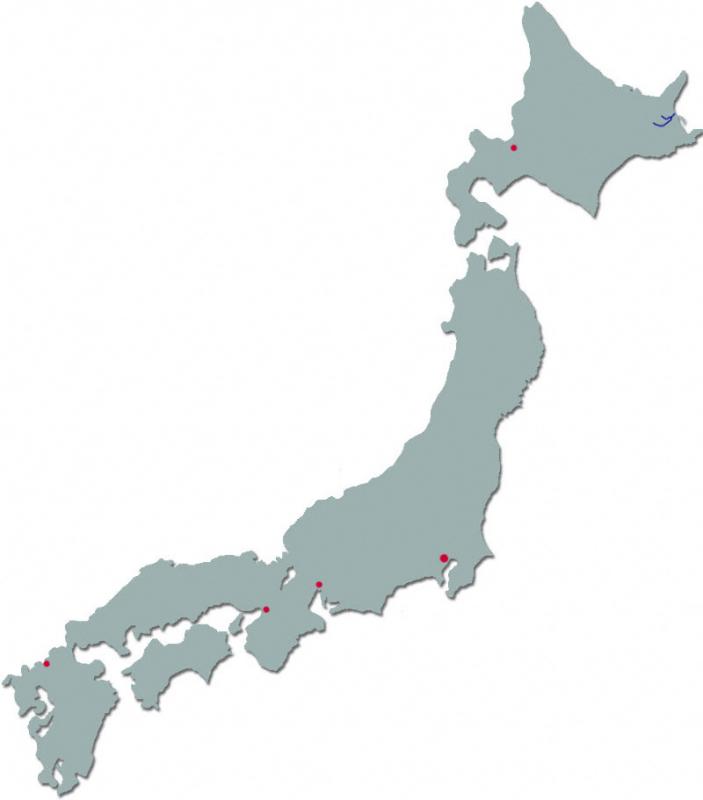 By the time I got to Japan twenty-five years ago, ecumenism was very strong. But it had not always been that way. One Protestant minister told me that when Father Pat Diamond sent an invitation to all the Protestant ministers in the City of Kumamoto to attend the opening of the new hall in Tetori parish, they got together to discuss whether it would be safe to attend or not. They prayed about it, but decided to risk death and attend. The rest is history.
By the time I got to Japan twenty-five years ago, ecumenism was very strong. But it had not always been that way. One Protestant minister told me that when Father Pat Diamond sent an invitation to all the Protestant ministers in the City of Kumamoto to attend the opening of the new hall in Tetori parish, they got together to discuss whether it would be safe to attend or not. They prayed about it, but decided to risk death and attend. The rest is history.
They where bowled over by the reception they got, met priests whom they found to be normal after all, and had a great party. “We discovered that Catholics really do believe in Christ,” said one of the ministers. That was the beginning of different churches working together in Kumamoto. Perhaps Father Pat Diamond did more for ecumenism there by that invitation than did Vatican II. Since then every Christmas Catholic and Protestant churches hire out the local threatre to hold a Christmas pageant. Catholic and Protestant schools stage the nativity in drama. On alternate years, the guest speaker is Catholic or Protestant.
When I first arrived in Kumamoto City I joined the ecumenical weekly meeting in a YMCA hall. It was held on Monday mornings between 6:30 and 7:30 am. The first half was spiritual – hymns, prayers and a short homily – and the second half was a simple breakfast. About thirty used to attend, mostly Protestants. I must admit. The zealous Catholics preferred to attend the 6:30 Mass in the local convent.
 As a newcomer, I was soon asked to lead the first half of the ecumenical meeting the following week as I was new, I decided to be both spiritually, biblically and politically correct.
As a newcomer, I was soon asked to lead the first half of the ecumenical meeting the following week as I was new, I decided to be both spiritually, biblically and politically correct.
“Fellow Christians and fellow heretics,” I began my talk, and received a thundering ovation.
“To us, you’re the heretic,” one minister quipped. From then on, we became the best of friends. When shopping, they used to park in our church grounds, and they used to borrow the hall for various events. When the YMCA hall went under repairs, the morning breakfast meeting moved into the Catholic church, where it still continues without a break every Monday morning.
They were a great group. The greatest of them all (apart from myself) was Mr. Horihara, an octogenarian from a Protestant church. He was the backbone of the ecumenical movement. His cry was “I protest nothing, I believe everything the Catholic church teaches. I believe in the Pope. I didn’t choose between Protestantism and Catholicism. When as young man I was disillusioned with life, I decided to become a Christian. I went to the first church I saw. It happened to be a Protestant church. There I met Christ, there I was baptized, there I now worship.”
When asked why he didn’t convert to Catholicism he replied “I could become a Catholic in the morning. I took lessons from Father Jim Norris; I have no difficulties with the Catholic teaching. I don’t just want to save my own life. I stayed in the Protestant church so that I could work on them to become more Catholic. If they all decided to become Catholics, then I’ll be in front leading them as they enter. My wish is that all Protestants attend the Catholic Mass, receive Holy Communion there and be united with Peter, the Pope.”
His ardent sincerity made a great impression on both Catholics and Protestants. At times his enthusiasm was hard to keep up with. He thought o could do miracles. He used to annoy some Protestants by quoting me too much – usually what he thought I should have said, rather than what I did say.
As he grow near ninety, still alert and agile, he, he announced that that he wanted his wake celebrated before he died. “What is the use of all those eulogies when I am dead when I can’t hear what you are saying about me? Tell me when I am alive.” Nobody would listen to him. His family was embarrassed.
At funeral in Japan, eulogies are very important. When his wife died a few years earlier, after listening for a while to many eulogies about “the wife of the well-known Mr. Horihara,” he stormed the microphone and said, “Why praise me? it is my wife who is dead. Praise her.”
He came to me and asked me to do his wake in my church while he was alive. I told him he was crazy and that he should let us have our say when he did die. My refusal disappointed him, I think. But he declared openly that he wanted his funeral to be organized from the Catholic Church.
He knew death was coming but still worked tirelessly for Christian unity. One day he set out with his daughter to visit the graves of his ancestors. It was a long trip. He visited the graves, booked into a hotel, had a hot bath and went to bed. He woke up dead the next morning.
His death caused a great shock in the Christian Community. The family explained to me how he wanted a Catholic funeral, but that this had upset his Protestant Community. I told them to have the whole ceremony in his church as they were the family he lived and died in. They where happy with this. A week later his whole family came to Mass offered for the repose of his soul – it was the first Mass they had ever attended. And they were delighted.
The spirit of Mr. Horihara lives on. The ecumenical meetings still carry on. It is powerful seeing Christians working in unity together; it is like the oil that runs down the beard of Aaron, as the Bible says. His words I” did not choose between Protestantism and Catholicism – I choose Christ” will long remain with me. He died with no regret – that all did not join the Catholic Church. Maybe not in body, but certainly in spirit we joined each other in Christ.
Following St. Francis
By Gee-Gee O. Torres
The village of Nong Din Dam in Thailand may seem very far away from the village of Assisi in Northern Italy but they are connected. A thousand years ago in Northern Italy, St. Francis burst upon the world to remind the Church that we must become a Church of service and a Church of the poor. Since then, thousands of people have followed in the feet of St. Francis and among them are the four Filipino Franciscan sister of the Immaculate Conception who have settled in the village of Nong Din Dam. I went to visit the sisters on my trip to Thailand. I enjoyed seeing the little ways and the projects which they have used as instruments of service for the poor and their way of following the Gospel. Let me introduce you to these four women.
Maka-Tao
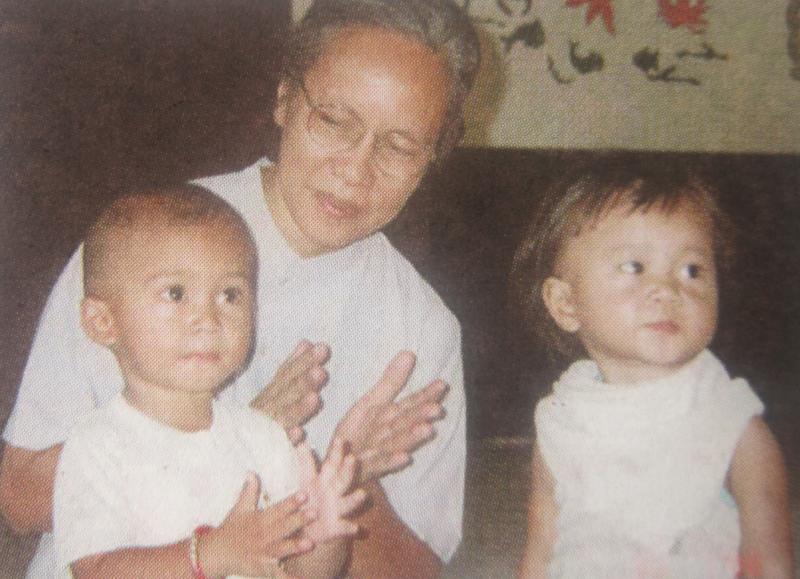 Sr. Lita has been on mission in Thailand for 14 years now. She considers her work ‘maka tao’. She runs a day care center where parents in the village leave their children before they go to work. St. Lita with the help of an assistant takes care of them. She integrates value formation and the spirit of sharing in their various activities. The children bring rice and the sisters prepare a nutrition meal for them. After lunch the children take a nap. Then they are given a bath before their parents collect them in the afternoon. Parents pay a small amount, but those who cannot afford the tuition fee give gifts like vegetable and fruits.
Sr. Lita has been on mission in Thailand for 14 years now. She considers her work ‘maka tao’. She runs a day care center where parents in the village leave their children before they go to work. St. Lita with the help of an assistant takes care of them. She integrates value formation and the spirit of sharing in their various activities. The children bring rice and the sisters prepare a nutrition meal for them. After lunch the children take a nap. Then they are given a bath before their parents collect them in the afternoon. Parents pay a small amount, but those who cannot afford the tuition fee give gifts like vegetable and fruits.
The mothers are also taught the proper way of taking care of their children and the right kind of food to give them. They have sewing classes, too. They make bags and nightwear which they sell to earn extra money.
I asked Sr. Lita how her vocation began. She answered, “It all started in high school when I first saw missionaries in my hometown in Zambales. Our school directors then were Columban Fathers Vincent O’Brien and Peter Kenny. After college I went back to teach in the same high school where I graduated and they were still there. My father was also an active lay minister in the parish run by the Columban Fathers vocation is not accidental. It wasn’t by chance that I was in that school.
Maka-Hayop
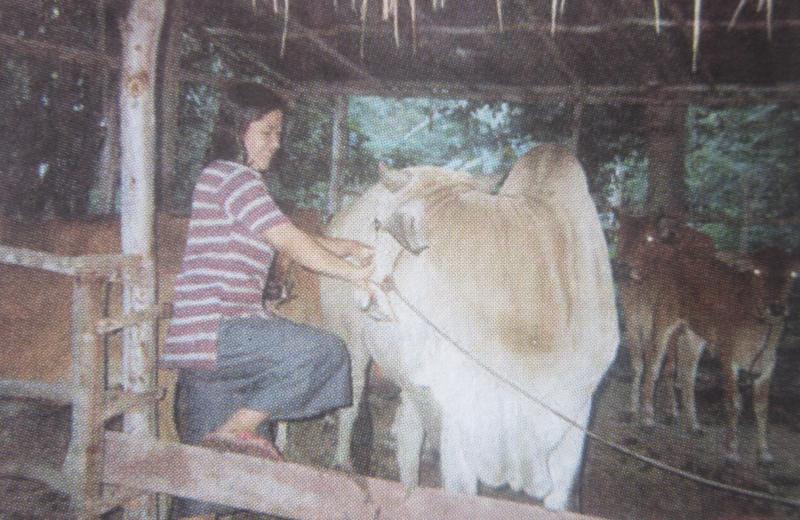 Sr. Luchi from Neuva Ecija graduated with a Bachelor degree in Animal Husbandry. When she joined the SFIC, she taught she would never practice her course. She thought sisters just pray all day and all night. However when she was sent on mission to Thailand, she was assigned in the animal care and production project. Now she is a full-time veterinarian, in short ‘maka-hayop’.
Sr. Luchi from Neuva Ecija graduated with a Bachelor degree in Animal Husbandry. When she joined the SFIC, she taught she would never practice her course. She thought sisters just pray all day and all night. However when she was sent on mission to Thailand, she was assigned in the animal care and production project. Now she is a full-time veterinarian, in short ‘maka-hayop’.
She started a livestock project with just 4 hens and a borrowed rooster from their parish priest, a cow and a calf, and two pigs. But today the animals have grown in numbers. Sr. Luchi distributed them to the villagers. The villagers raise the animals and give some of the offsprings to Sr. Luchi as part of their agreement.
“Animal care is physically tiring,” says Sr. Luchi. “I have to gather gabi, banana shoots and other herbs from the forest for the pigs, bring the cows to the grazing field and feed the chickens. But it’s fun, too. When our Superior came to visit us, we told her how. One day while we were dragging our cow to the village, the villager asked us, “Sister, where are you taking the cow?” (We wished they hadn’t asked.) We told them, “We’re looking for a mate, a bull.
Sr. Luchi finds the song Ang Panginoon ang aking Pastol meaningful as he pursues her mission assignment. Madilim na lambak man ay tatahakin ko, wala akong sindak siya’y kasama ko. Ang hawak niyang tungkod ay siyang gabay ko. Tangan niyang pamalo sigla’t tangulan ko.
Maka-Lupa

She initiated farming projects with the villagers. They planted rice. They where able to harvest 10 sacks of rice in the first year; but after that, production declined due to many factors like lack of fertilizer and water supply. Because of this the project was discontinued.
Sr. Carmen was given another assignment: to manage the newly–opened St. Francis Day Care Center. She enjoys teaching the pupils – basic English, value formation, Thai culture.
My work as a teacher has taught me the virtue of patience. First I have to learn the very complex Thai language. Secondly the children in school are restless. I always have to be on guard not to lose my patience. My personal commitment to Christ and His mission however keeps me going,” says Sr. Carmen.
Maka-Pera
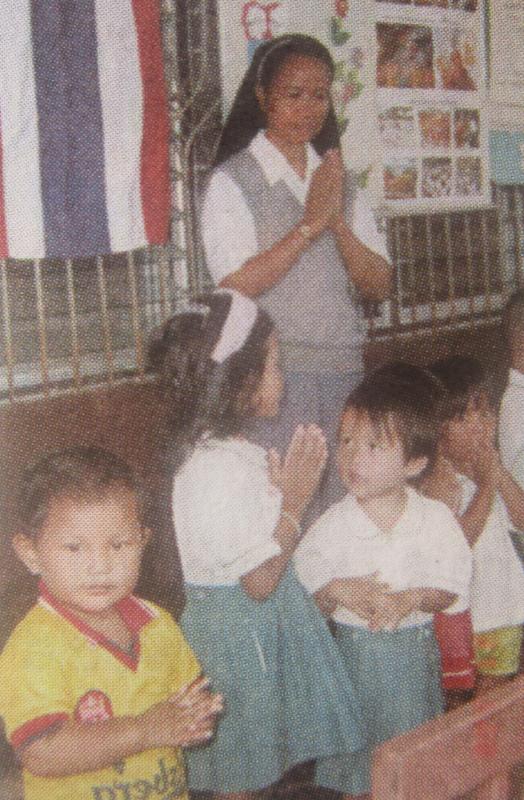
In 1983 she was sent to Thailand with Sr. Carmen. She studied the Thai language during the first year. The following year she began with her mission: to teach the villagers the value of saving. She taught of putting up a cooperative. But the parish priest discouraged her because the cooperative there failed before. Sr. Beth was determined to pursue her project. She looked for a group with fixed income. She approach Sr. Lita’s group of mothers if they were interested in her project. They were and so began the coop.
For the few years it was successful. It helped them in their financial needs. But problems arose. The number of the members attending the meetings decreased. And when Sr. Beth suggested to increase their monthly contribution, their enthusiasm waned significantly. So the cooperative stagnated. But this year they want it revived.
“Life is never a sacrifice if it is lived out of love. And I love to live here. It feels great to be with the people – cultivating values, fostering family spirit and building communities,” tells Sr. Beth.
It would be beautiful to have all our projects succeed but, after all these projects are only vehicles for sharing the love of God and our Filipino Sisters have certainly succeeded in this.
No Time To Play
By Michael L. Tan
Around my parents’ home in San Juan, I have watched through the years street child vendors grow up. I remember one of them very distinctly because he has a congenital condition in his eyes that always made him look like he was half asleep. He survived selling cigarettes, year after year. I watched him as he grew into adolescence. Then he disappeared from the streets, only to pop up again, now a young man driving a pedicab. He’d made it in his own way. We need to hear from him and others like him. We know what goes wrong. What we need to know is what went right -- the difference that allows the children not just to survive but to thrive in a society that’s only now beginning to accept childhood.
Media publicity and documentaries about child labor are important for waking people up. But there is, too, the danger of denial and hopeless despair. Problems are so clearly related to poverty, indebtedness and social justice, but it would be defeatist to say nothing can be done, even if a small way. Here are some suggestions...
First
Start with your own backyard. A little kid came to our door one day. He was the child of one of our neighbors’ household helpers and had been sent to borrow our coconut grater as well as to have me look at his sick cat. The kid looked even tinier because the cat was so huge, its hindfeet almost touching the ground as he carried it. Seeing him reminded me there are so many kids like him in our own homes and those of our friends and relatives. Make sure these children are not trapped into vicious cycle of becoming another generations of domestics. (I have actually met people whose household help are the grandchildren of their grandparents’ helpers.)
Second
Educate yourselves about this problem. We’re talking about 3 to 4 million Filipino children here, not just the street kids we see in Manila but many more in the sordid conditions of farms, mines sweatshops. By a copy of the documentary Minsan from the Ateneo Center for Social Policy (Tel. No. 924-4601). Part of the proceeds goes to child labor welfare funds. (An earlier documentary by Carolino, No Time for Play, is also available at Bookmark.) Arrange to show these films at a community or neighborhood function and discuss the issues.
Third
Find some way to help support the children, not through one-shot charity donations but through a more sustained program of support. Child labor is not just a symptom of poverty. It also traps children in this vicious cycle of poverty. Education offers a way out of this trap. But let’s not forget that we do in fact have free (and supposedly, compulsory) education up to the high up to the high school level. Tuition is free but there are all kinds of other expenses for books, for meals and the usual ‘donations’
Even more important is the social support to encourage impoverished youth to stay in school, rather that succumb to the temptation of working to help the family out. Public schools are over burdened and teachers do not have time to give the one-on-one guidance that young people need.
Fourth
Help to educate parents. For most of human history, children have been seen as extra labor. The notion of childhood as a time for leisure, play and schooling is a product of recent modern history. Many parents – and not just from the poor – have yet to come to terms with this newer concept, as well as that of children having rights.
Fifth
Set up support services for child laborers. Recognizing that child labor will continue for some time we need to at least find ways to ensure more humane and safe conditions.
Sixth
Coordinate with the groups that are in here for the long-term. Child advocacy groups are a peso a dozen these days. The problem are so complicated so I would be careful to avoid traditional “charity” approaches here. The International Labor Organization have launched a global campaign against child labor. You can contact them and find out what long-term programs they have. This would be ILO-Ipec (Tel. No. 894-3928)
Prayer In The Loob
Fr. Jerry Pierse, cssr
Since I started working, said Rose one night at our prayer meeting, I used to spend more than half of my earnings on cosmetics, manicures, pedicures, and the like. Recently, I notice I have stopped doing that. I never made a decision to stop. The change came from somewhere inside me.
At this stage Rose had been in our meditation group for about a year. What happened? I think that what happened is this: Rose had a very poor self-image and thought that she had to beautify herself to be attractive to people. When she sat in silent meditation she came to realize deep in her core, in her loob, that she was loved and beautiful before God. So her impulsive need to beautify herself ceased. When change happened in her loob her behavior followed.
In English we call the place where the Spirit dwells, where our interior truth comes from, the heart. However, the most accurate word to describe that mysterious place, that I know of in any language, is the Tagalog loob. I have been asking for a Visayan translation for the word or the word but no word “boot”, “kina-uyokan”, “kaugalingon” seems to have quite the same nuance as kalooban. If there is a debt or a hurt or a joy in the loob there is a particular force about it that is not captured fully by English word heart.
Loob, according to the lay Doctor of Theology, Jose de Mesa, is the inner self, the core of one’s personhood and where the true worth of a person lies. It is what makes a person what he or she is. It is the ultimate organizing center of human reality. It is the substratum within is from which ideas, feeling and behavior emerge.
Loob is also the place from which a personal relationship with others emerges. A person’s way of relating is described according to their loob. A person who relates well with others is said to have “magandang loob” or “mabuting loob.” Such a person is not only well intentioned but promotes the well-being of others by actual deeds. On the other hand, to say that someone is “masamang loob” means that this is a person of bad character as shown in their way of relating to others.
But a person’s relationships with self and others are of one piece with their relationship with God. If I am clinging or demanding in my relationship with others, it is 100% certain that I will also be clinging and demanding within myself and in my relationship with God. Loob, then, is also the place from which relationship with God emerges. It is the place of prayer. It we are all temples of the Holy Spirits, as St. Paul tells us, then the loob is the place within us where the Spirit dwells. To be present in a healthy way to the loob is to be presenting a healthy way to oneself, others and God. Prayer is being at home within our loob. It is cleansing the loob and being set free from within the loob.
Christian prayer is to be present to the presence of God. This God has been revealed to us as a Trinity. We try to be present to the Father/Creator God especially in our worship and in our devotions. We try to be present to the Son of God, who came one of us, in the people and the world around us especial in the Basic Christian Community. We are present to the Spirit when we are present to our loob.
Christian Meditation is a way of being present to one’s loob. It is a way of being present to be the giftedness and sinfulness within one’s self with compassion and joy. When we are silently and lovingly present there our natural instinct to move towards wholeness is set free. We become better within ourselves and the fruit of this is seen in our relationships with others. It is not the only way of prayer but it is a way of prayer but it is a way of prayer that begins at our core and moves out from there to transform all other relationships.
According to the Benedictine teacher Fr. John Main this is how to Meditate: sit still and upright, relaxed but alert. Close your eyes lightly. Silently, interiorly begin to say a single word. John Main recommends the prayer-phrase “Ma-ra-na-tha.” Listen to it as you say it, gently, but continuously. Do not think or imagine anything – spiritual or otherwise. Thoughts and images will likely come, but let them pass. Just keep returning your attention – with humility and simplicity – to saying your word, from the beginning to the end of your meditation. Try to do this daily 20 to 30 minutes a.m. and p.m.
The Courage To Say No
Everyone talks about the way the problem of graft and corruption is undermining our society but then when one is personally tempted, we charge our tune: saying ‘no’ becomes suddenly difficult and we look for all kinds of excuses to justify our actions. Strong conviction and will power are needed to overcome these temptations.
I Need a Motorcycle
Take the case of a friend of mine who needed a motorcycle to beat the traffic to work and save on his car’s gasoline. He couldn’t afford it though. One day he made the mistake of mentioning this to one of the company suppliers he was dealing with. Since he was the purchasing manager, many suppliers were trying to win him over with a commission or gifts. So far, it had been quite easy to refuse such benefits and apply them to his company, as a discount. One day, however, he came home and found beautiful motorcycle. The challenge was a little so much! However, he thought about it for a while, and even though the temptation was there and the excuses sounded right – “after all, who will ever come to know,” “I badly need it;” “it will not change my attitude towards this supplier,” he decided to call the not – so – anonymous sender.
Not in this Way
Imagine the astonishment of the person on the other end of the line when he was asked to send someday over the pick up the motorcycle right away. “But I thought you needed it,” the supplier exclaimed. “Of course, I do not need it, but I will buy one when I earn the money myself, and not in this way,”
Almost Tempted
The next day the motorcycle was gone. Later, he admitted how strongly he had been tempted to keep it, but not to the point that it could wipe away his convictions. However, if I had waited another day, maybe I wouldn’t have had the courage to say NO.”
No!
Deep in our hearts we all have the courage to say NO, or better, the readiness to do what is right. Yet sometimes we need a reminder that it is with small but courageous acts like the one mentioned above. That we can hope to build a new future for our nation.
Why I Bought Slaves
By Caroline Cox
After a visit to Sudan, Baroness Cox reports on the slaughter of Christians and animists by raiders backed by the country’s Islamic regime. She explains how she, and the organization Christian Solidarity Worldwide with which she traveled, were driven to enter the slave trade.
The Catholic catechist Santiago Ring was standing in the ruins of his church at Mayen Abun in northern Bahr-El-Ghazal in the borderlands between southern and northern Sudan. The beautiful brick church had withstood attempts by Muslim raiders from the north to burn it down, who destroyed all that could be destroyed and tried to shoot down the cross from the roof. Santino stood by the empty ruin holding one of the drums traditionally used to make a joyful accompaniment to worship, which had been slashed by soldiers.
He told us what happened in the fateful day in April when government troops with armed jeeps, camels and fast horses swept into this part of Bahr-El-Ghazal. First they attacked the thriving market at Aben Dau, killing hundreds of civilians including children; they then pursued and massacred those trying to escape into the bush; and stole tens of thousand of cattle; they pillaged homes before burning them and setting fire to crops; then they moved on, killing, plundering and burning. Most of those who live in Bahr-El-Ghazal are African Dinka people, mainly Christians and animist, persecuted by the fundamentalist Islamic regime in Khartoum, the capital of Sudan.
Traveling with a group from Christian Solidarity Worldwide (CSW), I was in the area two weeks after these raids and I saw the devastation at first hand: human and animal corpse were strewn as far as the eye could see; charred remains of homes and crops were all that was left of village after village. Those who had managed to escape had fled to swamps where their attackers could not follow.
At Mayen Abun, the raiders continued their savagery. Santino’s sister was taken as a slave and her husband was killed. Santino was left to care fro his sister’s four children. With all crops burnt, they were reduced to eating tamarind seeds.
We were shown bloodstained patches on the ground where we were told the raiders had cut the throats of three women and a child; nearby, we were shown charred human remains in a hut which had been set alight. Santino claimed that two men were thrown alive into the conflagration.
But for me the most poignant moments were when Santino talked about the faith of his people. He told us that several hundreds would still come to church, emerging from hiding to worship. He said with profound sadness, that they felt abandoned by Christians in the rest of the world. They were trying to hold a frontier against a fundamentalist, totalitarian Islamic regime committed to polices of enforced Arabisation and Islamisation; if they gave up the struggle, militant Islam would spread to neighboring African countries – and perhaps further afield. But until we came nobody had visited them for several years. They felt isolated, forgotten, abandoned.
As he stood in the ruined church with his sister’s children who had lost their father to the bullet and their mother to slavery, his plaintive question, “Doesn’t the Church want us anymore?” broke our hearts. Those words challenge us who live in comfort, in countries where we do not have to pay a price for our faith. How often do we remember St. Paul’s messaged to the Church of Corinth: “When one part of the body of Christ suffers, we all suffer.”
Christian Solidarity Worldwide (CSW), based in New Malden, Surrey, works for victims of repression, regardless of creed or color, and it never proselytizes. But when it encounters Christians facing persecution, it tries to show solidarity with them. Their first request is always prayer. It is humbling. Even if they are dying of disease and have no medicines; of starvation and have no food; even if they are naked and are cold, prayer is still their priority.
The media has portrayed the tragedy of those who are dying from famine caused by drought and floods, but there has been little coverage of the horror’s inflicted by the government’s policy of ethic cleansing of the African Dinka tribes from these fertile and oil-rich borderlands.
During our most recent visit we were able to take essential medical supplies and to assist in the buying back of some of the slaves who had been abducted during the raids in April, or who had been in slavery for longer. Of course, buying the freedom of the slaves who had been abducted during the raids in April, or who had been in slavery for longer. Of course, buying the freedom of the slaves is not a long-term solution to the Government’s policy of encouraging this age-old practice. The national Islamic Front regime has elevated it to new dimensions by participating in the raids with its own well-equipped forces and by arming the Mujahidin warriors with automatic rifles and fast horses.
It is possible for some of the friendly, peaceable Arab traders to negotiate the freedom of some slaves and to bring them back to their communities. But many of the Dinkas have lost everything in the raids and have no resources with which to buy the freedom of their loved ones.
Some assistance with resources can enable local community leaders to buy back women and children for families who have lost everything. For that reason, a macabre and intensely harrowing part of our visit was spent engaging in the slave trade. Controversial? Of course, but does one look into the eyes of a mother or a child and tell them that they must remain in slavery until a political solution is found for the conflict in Sudan? On this visit we were able to make it possible for Santino’s sister to be restored to their children and for the wife of one of the men thrown into the burning hut to be bought back. We will not forget her radiant smile as she exclaimed, despite all the suffering, how happy she was to be free.
But buying back slaves is not our only response. On a previous visit, Mubararrak el Mahdi, a grandson of the famous el Mahdi who defeated general Gordon in Khartoum, courageously accompanied a mission to this area to meet the peaceable Arabs who visit the south in the dry season to trade and to graze their cattle in the fertile pastures. In huge meetings under the spreading mango trees, he told his Arab brothers that they were being manipulated by the government and that they must stop attacking, killing and enslaving their African neighbors. We were told on subsequent visits that the Government was finding it much more difficult to find recruits for these raids.
Christian Solidarity Worldwide is working in the political arena to highlight the practice of slavery and to press the National Islamic Front regime to open up all the Sudan to human rights monitors to identify and free those still in slavery. We estimate, on the basis of numerous visits and first-hand evidence of slave raids, that tens of thousands of Africans have been enslaved. There are reports that many have already been exported to other countries. This makes the need for a slave-tracing programme even more urgent, to rescue them before they vanish forever.
If you had been with us and spoken to some of those we met, you would be convinced of the need for action. You would have met young Dinka slave boys who could only speak Arabic and who could recite verses from Koran, which they would never have learnt in their local communities. You would have seen the scars on the bodies of the women and children who had been beaten. And you have witnessed the macabre transactions whereby these victims of the Government’s policy of enforced Arabisation and Islamisation were bought back.
The price? On average, the price of freedom for a slave in Southern Sudan is the equivalent of three heads of cattle -- $100. At least Santino’s sister is free. And so are 400 other slaves. But countless others still suffer and die in the tragedy, which is Sudan today. Many southern Sudanese Christians refuse to go to government towns and garrisons for the food and medicine which could alleviate their suffering and keep them alive. They know they will have to forfeit their Christian faith and adopt Muslim names and practices as the price for survival. They claim they would rather die than forfeit their faith.
